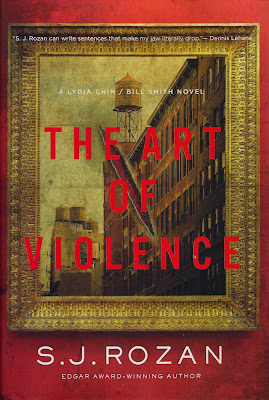This book won the Pulitzer Prize for fiction in 2009, and was described at that site as:
A collection of 13 short stories set in small-town Maine that packs a cumulative emotional wallop, bound together by polished prose and by Olive, the title character, blunt, flawed and fascinating.
Olive Kitteridge is the focus for many of the stories. Within the confines of her family, Olive's behavior can be very volatile and damaging. She is a controlling mother to her son Christopher and somewhat abusive. In her life outside the home she has a reputation for being disagreeable and prickly. Yet at times she can be helpful and kind to friends and neighbors.
The first story, "Pharmacy," focuses on Henry, Olive's husband, and is told from his point of view. Of course it tells us a lot about Olive, their marriage, and some about Christopher, their son. That story is a fantastic opener for the book. Henry is a genuinely good, considerate, generous man, who tries to think the best of all people at all times. From what we know of Henry in the stories in this book, he is this way with everyone: with his family and the customers he meets at his pharmacy and neighbors in the community. He also tries to mediate between his son and Olive.
There are only four or five stories (out of thirteen) that focus primarily on Olive and her thoughts and reactions to people. The other stories focus on incidents experienced by families within the community of Crosby, Maine. Each story contains at least one appearance or mention of Olive. Sometimes the story is not about her but she takes an active part.
The other stories provide other viewpoints of Olive and her behavior. Those stories are still good, just not my favorites. And some of the stories were distressing to read. The stories cover Olive and Henry's life together and spans decades of their lives, but most of them are about the later years.
My thoughts:
The stories in this book provide an interesting picture of small town life in Maine. The emphasis was on people that have particularly problematic lives and relationships, and I am sure that communities like this one have many "normal" families also. Some stories related to old age, life after losing a spouse, and suicide.
I found most of the stories to be depressing. I am sure that this is not true for every reader, but it was true for me. Several of the stories were about damaged families with children who were affected by the situation. There we some rays of light, some people who escaped from their situation and were looking for a better life for them. Most nights I read only one story from this book, and had to stop for the night. Yet I liked the book quite a lot. Olive is a wonderful character regardless of her flaws. I was never bored.
The last two stories that were primarily about Olive were exceptional. In "Security," Olive visits her son and his new family; it was emotional, unsettling at times, but not so depressing. "River" ended on a positive note.
I will read Olive, Again, the second book of stories about Olive Kitteridge, and I will read more books by this author. I have My Name is Lucy Barton on my TBR. Elizabeth Strout is a fantastic writer and had me sympathizing or empathizing with many of the characters.
-----------------------------
Publisher: Random House, 2008
Length: 270 pages
Format: Trade paperback
Series: Olive Kitteridge
Setting: Small town in Maine
Genre: Fiction
Source: I purchased my copy

























